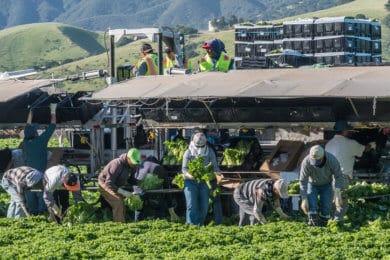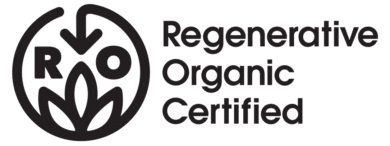What’s Next for Sustainable Agriculture?
Beginning in 2003, Dr. Bronner’s committed to sourcing all major raw materials for its products from organic farms. It was apparent to the company’s leadership that industrial agriculture, with its unchecked use of synthetic pesticides and fertilizers, was doing great harm to our planet: from nitrogen and phosphorus-fueled dead zones in the Gulf of Mexico that are the result of fertilizer runoff, to colony collapse disorder in bees that is the result of the rampant use of neonicotinoid pesticides, industrial agriculture’s toll on ecosystems and wildlife is tragic in its scale and scope. Organic agriculture, which eschews use of chemicals, synthetic pesticides, GMOs and petroleum-based fertilizers, has provided a crucial alternative to the disaster of large-scale industrial agriculture.
Nearly 15 years later, the understanding of what constitutes good farming practices has come a long way. Farmers, scientists and activists are converging on the idea that organic agriculture must be not only sustainable but also regenerative: farmers must nurture the soil—the fundamental medium on which agriculture depends. The complex science of soil is advancing rapidly, and these new insights are revolutionizing our understanding of what sustainable and restorative agriculture should look like.
Healthy soils are host to an intricate web of life that includes plantroots, mycorrhizal fungi, bacteria, worms and insects. Soil is not merely dirt—an inert medium—but a dynamic living membrane. The life that thrives in the soil, once it decays, becomes soil organic matter, building up soil’s carbon content. This carbon-rich soil is able to retain more water and naturally nourish plants, helping the plants ward off pests and disease.
Regenerative organic agriculture is the idea that we must foster this rich soil ecosystem in every way possible. The methods for doing so are varied—they include minimal disturbance of the soil (conservation tillage), fertility-building cover crops, diverse crop rotations, compost and rotational grazing of farm animals. When used in combination, these methods have proven to be powerful tools not only for restoring soil fertility, but also for drawing down atmospheric carbon and sequestering it into the soil. While industrial agriculture as practiced today is one of the main drivers of greenhouse gasses and climate change, regenerative organic agriculture at global scale has the potential to sequester gigatons of carbon and mitigate climate change’s worst effects.
The Need for Regenerative Organic Standards
Regenerative organic agriculture is not exactly a new idea, although it has been greatly advanced and refined by modern research and the scientific verification of its methods. The roots of regenerative organic lie both in traditional agricultural methods around the world, as well as the original ideas of organic pioneers such as Sir Albert Howard, J.I. Rodale and Rudolf Steiner. Both traditional societies and these organic pioneers recognized that sustainable agricultural techniques depended on achieving a healthy balance between animals, plants and soil.

As the organic agriculture movement gained traction in the 20th century, some of its proponents also saw the need to include worker and farmer rights as part of a holistic agricultural system. These pioneers saw that it would be fruitless to grow healthy food and maintain healthy ecosystems if the people working the soil and growing the food were not being treated justly in the process. Segments of the organic movement still hold that organic farming should be as much about protecting farmworker health and maintaining thriving rural communities as it is about growing healthy foods.
These organic pioneers, and the generation of farmers who now follow in their footsteps, set the bar for holistic regenerative organic agriculture. But as the rules of organic farming became codified and as governments around the world began adopting standards by which farmers could certify their crops as organic, many of these original ideas fell by the wayside in order to implement a simpler, narrower standard. Buidling soil health, so integral to the original intent, is not practiced and enforced as it should on many farms. These farms often import fertility into farm soil from external factory farm manure, instead of building fertility holistically on the farm in a closed-loop cycle via regenerative methods.
Meaningful labor regulations were also left out: large agricultural corporations wanted to use the new organic certifications to their benefit but did not want to improve poverty wages nor unsafe conditions in the migrant agricultural labor system. While fair trade standards rose up to try to fill the labor justice gap that was left by the organic certifications, it meant that these two facets of what makes a healthy farming community were now fragmented.
The lives of farm animals were improved by organic standards, but not nearly enough. Organic meat and dairy has come to mean mostly that the farm animals are consuming organic feed—not that animals were raised on pasture. Overall, animals raised on organic farms fare much better than those raised on conventional farms, though the conditions in which they are raised and slaughtered are still not necessarily humane, and organic standards require only a minimum of space and outdoor time for these animals.
High-bar Regenerative Organic Certified standards that include soil health, farmworker justice and animal welfare, not only fill in the gaps left behind by organic certification, but also help codify practices within the regenerative organic movement itself. It is our belief that regenerative agriculture should absolutely include and build on organic agriculture as a baseline. We are joined in this position by our allies in crafting Regenerative Organic Certified standards, including Rodale Institute, Fair World Project, Compassion in World Farming and Patagonia. Regenerative organic agriculture is a chance to reclaim the original intent and foundation of organic agriculture, and is not merely meant to replace it. Organic certifications, with their focus on minimizing synthetic inputs are still crucially important: we do not need to be spraying these poisons into our air or polluting our waterways with them.
The Three Pillars of the Regenerative Organic Standard
Working together with Rodale Institute, Patagonia, and several other non-profits, businesses and activists, we have developed a standard for Regenerative Organic Certification that farmers and producers can now use to certify their products as regenerative organic. These standards have completed their pilot phase and the Regenerative Organic Certified seal can now be seen on products, including Dr. Bronner’s Regenerative Organic Coconut Oil. The Regenerative Organic Certification standards as developed include these three pillars: Soil Health and Land Management, Animal Welfare, and Farmer and Worker Fairness.

Here are the practices outlined in each of the three pillars of the standards:
Soil Health and Land Management
Practices that certifying farmers can use to preserve soil health, soil fertility and biodiversity include:
- Use of cover crops and diverse crop rotations (in particular, nitrogen-fixing legumes) to prevent soil erosion as well as help control weeds and pests.
- Conservation tillage—minimally disturbing soil to maintain soil microbial communities and structure, while preventing carbon loss into the atmosphere.
- Rotational grazing—rotating grass-fed and finished cattle through pasture in paddocks so that pasture is allowed plenty of rest between grazing and ruminants can fertilize fields with their manure.
- Self-sufficiency in achieving soil fertility through use of compost, manure, mulch and organic waste, leaving out any synthetic fertilizers.
- No use of chemical pesticides and no deforestation.
Animal Welfare
Practices that certifying farmers have to comply with to ensure that animal welfare standards are met include:
- No Confined Animal Feeding Operations (CAFOs), defined by the USDA as “a farm in which animals are raised in confinement that has over 1,000 animal units confined for over 45 days a year.”
- Animals are free from hunger and thirst, given ready access to fresh water and a diet that maintains their health and vigor.
- Animals are free from discomfort, meaning that they are provided an appropriate environment including shelter and a comfortable resting area
- Animals are free from pain, injury or disease—meaning adequate disease prevention measures are implemented and proper diagnosis and treatment is provided.
- Animals are free to express normal behaviors by providing sufficient space, proper facilities and company of the animal’s own kind.
- Animals are free from fear and distress by ensuring that conditions, treatment and slaughtering systems avoid mental suffering, and transport distances to slaughter facilities are minimized.
Farmer and Worker Fairness
In order to be certified as regenerative organic, farms have to comply with the following labor standards:
- No child labor
- No forced labor
- No abuse or sexual harassment
- No discrimination
- Freedom of association and right to collective bargaining
- Living wages
- Fair pricing for goods
- Safe working conditions
- Long-term commitments from buyers
- Staff training and capacity building
How to Support Regenerative Organic Agriculture
Organic products have experienced exponential growth in the last couple of decades, a trend that has been largely consumer-driven. Because consumers have been demanding healthier food, grown with respect for the environment, companies have stepped in to provide customers with products they can trust. In much the same way, consumers can demand that brands, farmers and producers take the next big step and make their products not only organic, but regenerative organic. Consumers have the power to ensure that our planet’s future contains healthy soils and healthy communities, as well as mitigate the worst effects of runaway climate change. In the same way, consumers must choose to eat less meat, and when eating meat, to choose only pastured and humanely-raised meat, dairy and eggs from high-bar certified sources like Animal Welfare Approved, Certified Humane, Global Animal Partnership (GAP), and Regenerative Organic Certified. It is ultimately the only choice for any ethical and ecologically-minded consumer.